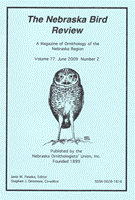Nebraska Ornithologists' Union

Nebraska Bird Review
Date of this Version
12-1991
Document Type
Article
Citation
Sidle, Wilson, Dingle, Lackey, Wingfield, Good, Lingle, & Plettner, "The 1991 Census of Least Terns and Piping Plovers in Nebraska," in Nebraska Bird Review (December 1991) 59(4). Published by the Nebraska Ornithologists' Union.
Abstract
We counted least terns (Sterna antillarum) and piping plovers (Charadrius melodus) in Nebraska during June and July, 1991. This undertaking was part of an international effort to census the threatened piping plover throughout Canada and the United States. The U.S. Fish and Wildlife Service (USFWS) (1988) has called for the censusing of piping plovers every five years to monitor the status of the species and to gage the effectiveness of recovery efforts. This first international census of the piping plover has been organized by the USFWS's Great Lakes/Northern Great Plains Piping Plover recovery team. The census is one of the first attempts to complete a total count of one species of breeding shorebird.
The least tern in the Great Plains is endangered and also requires periodic censusing (USFWS 1990). Because both species nest on the same river sandbars and adjacent sand and gravel pits (sandpits) in Nebraska, least terns were counted during the census of piping plovers.
Study Area and Methods
The distribution of the least tern and piping plover in Nebraska has been well known for several years. The Nebraska Game and Parks Commission, Platte River Whooping Crane Habitat Maintenance Trust, USFWS, and others began censusing in the late 1970s. In the intervening years most stretches of river and sandpits used for nesting were identified.
Sandpits (Figure 1) are areas mined for the commercial sale of sand and gravel and are usually located within 2-3 miles of a river. Three areas we included as sandpits consisted of sand and gravel that had been side casted along diversion canals from the Loup River (Loup River Diversion), South Platte River (Korty Diversion), and from near the confluence of the North and South Platte rivers (Central Diversion). Periodic dredging to keep the canals open creates and maintains a large expanse of barren sand and gravel. The barren sand and gravel at pits is similar to the barren sandbar substrate found in rivers (Kirsch 1991, Lingle 1990, Wilson 1991). We also surveyed pits that were no longer being actively mined but contained some suitable nesting substrate. Vegetation eventually will cover inactive sand and gravel areas and render them unsuitable as nesting habitat.

